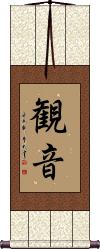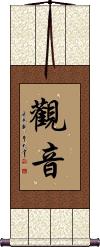Many custom options...
And formats...

観音 in Chinese / Japanese...
Buy an 観音 calligraphy wall scroll here!
Personalize your custom “観音” project by clicking the button next to your favorite “観音” title below...
Goddess of Compassion
観音 is the specifically Japanese version of Bodhisattva of Compassion or Guan Yin.
In Japanese, this is pronounced Kannon and occasionally spelled Kwannon. The Chinese version is a bit more commonly seen in Asia. However, in Japanese, there is a slight variation with the first character.
Some time ago, a camera company in Japan named their company after this Buddhist deity. That camera company is still known as Canon (they chose a “C” instead of a “K” when they Romanized this name).
Goddess of Mercy and Compassion
觀音/観音 is the Buddhist deity known as the Goddess of Mercy or Bodhisattva of Compassion.
In Chinese, the proper name of this being is Guan Yin. There is some debate as to whether Guan Yin is female. The argument comes from some scripture that suggests Buddhist deities take on the male form. Others say that Guan Yin has no sex. And still, others are okay with the female representation of Guan Yin.
This bodhisattva is also known or Romanized in the following ways:
Mandarin Chinese: Guan Yin, Kuan Yin, Kwan Yin.
Japanese: Kannon, Kwannon.
Sanskrit: Bodhisattva Avalokitesvara.
Korean: Gwan-eum.
Vietnamese: Quan Âm.
Thai: Kuan Eim.
English: Bodhisattva of Mercy and Salvation, Goddess of Compassion, Buddha of Mercy, et al.
Note: The first character has a slight variation in Japanese. If your audience is specifically Japanese, you may want to select that version.
Senju Kannon
Not the results for 観音 that you were looking for?
Below are some entries from our dictionary that may match your 観音 search...
| Characters If shown, 2nd row is Simp. Chinese |
Pronunciation Romanization |
Simple Dictionary Definition |
観音 see styles |
mine みね |
More info & calligraphy: Goddess of Compassion |
千手観音 see styles |
senjukannon せんじゅかんのん |
More info & calligraphy: Senju Kannon |
一観音 see styles |
ichikannon いちかんのん |
(place-name) Ichikannon |
七観音 see styles |
shichikannon しちかんのん |
(1) (See 観世音) the seven forms of Avalokitesvara; (2) the seven Avalokitesvaras of Kyoto; (place-name) Shichikannon |
元観音 see styles |
motokannon もとかんのん |
(place-name) Motokannon |
六観音 see styles |
rokkannon ろっかんのん |
(See 六道) the Six Forms of Avalokitesvara (one for each of the six realms); (place-name) Rokkannon |
南観音 see styles |
minamikannon みなみかんのん |
(place-name) Minamikannon |
岩観音 see styles |
iwakannon いわかんのん |
(place-name) Iwakannon |
新観音 see styles |
shinkannon しんかんのん |
(place-name) Shinkannon |
東観音 see styles |
higashikannon ひがしかんのん |
(place-name) Higashikannon |
正観音 see styles |
shoukannon / shokannon しょうかんのん |
(Buddhist term) Aryavalokitesvara (manifestation of Avalokitesvara) |
百観音 see styles |
hyakkannon ひゃっかんのん |
(place-name) Hyakkannon |
石観音 see styles |
ishigannon いしがんのん |
(place-name) Ishigannon |
穴観音 see styles |
anakannon あなかんのん |
(place-name) Anakannon |
聖観音 see styles |
shoukannon / shokannon しょうかんのん |
(Buddhist term) Aryavalokitesvara (manifestation of Avalokitesvara) |
西観音 see styles |
nishikannon にしかんのん |
(place-name) Nishikannon |
観音下 see styles |
kanagaso かながそ |
(place-name) Kanagaso |
観音作 see styles |
kannonsaku かんのんさく |
(place-name) Kannonsaku |
観音前 see styles |
kannonmae かんのんまえ |
(place-name) Kannonmae |
観音北 see styles |
kannonkita かんのんきた |
(place-name) Kannonkita |
観音原 see styles |
kannonbara かんのんばら |
(place-name) Kannonbara |
観音台 see styles |
kannondai かんのんだい |
(place-name) Kannondai |
観音向 see styles |
kannonmukai かんのんむかい |
(place-name) Kannonmukai |
観音坂 see styles |
kannonzaka かんのんざか |
(place-name) Kannonzaka |
観音堂 see styles |
kannondou / kannondo かんのんどう |
temple dedicated to Kannon; (place-name) Kannondou |
観音子 see styles |
kanoko かのこ |
(female given name) Kanoko |
観音寺 see styles |
kannonji かんのんじ |
(place-name, surname) Kannonji |
観音山 see styles |
kannonyama かんのんやま |
(place-name) Kannon'yama |
観音岩 see styles |
kannoniwa かんのんいわ |
(personal name) Kannon'iwa |
観音岬 see styles |
kannonmisaki かんのんみさき |
(personal name) Kannonmisaki |
Click here for more 観音 results from our dictionary
The following table may be helpful for those studying Chinese or Japanese...
| Title | Characters | Romaji (Romanized Japanese) | Various forms of Romanized Chinese | |
| Goddess of Compassion | 観音 | kan non / kannon | guān yīn / guan1 yin1 / guan yin / guanyin | kuan yin / kuanyin |
| Goddess of Mercy and Compassion | 觀音 / 観音 观音 | kan non / kannon | guān yīn / guan1 yin1 / guan yin / guanyin | kuan yin / kuanyin |
| Senju Kannon | 千手観音 | senju kannon senjukannon | ||
| In some entries above you will see that characters have different versions above and below a line. In these cases, the characters above the line are Traditional Chinese, while the ones below are Simplified Chinese. | ||||
Successful Chinese Character and Japanese Kanji calligraphy searches within the last few hours...






